 david coombe history
david coombe history
SUMMARY: S.T. Gill continued to portray South Australia well after he left there in early 1852. He also transformed some South Australian work into generic bush subjects. This article lists works I think are Gill's retrospectives of South Australia, with an emphasis on the works Appleyard dated in the South Australian years.
Article type: ANALYSIS
In this article ...
Gill continued to portray South Australia well after he left there in early 1852. He also transformed some South Australian work into generic bush subjects.
The scope of this project is Gill's works in South Australia (to 1851) and his earliest works in Victoria (1852-53). Later works are out of scope, including many retrospectives of South Australia.
Appleyard, et al, placed some works in Gill's South Australian years, whereas I've concluded they are retrospectives. So I thought it necessary to deal with those differences here. In particular, Appleyard thought some pencil sketches were original field sketches for Gill watercolours. Instead I think they are subject revisitings. This implies Gill's early watercolours and later pencil sketches were both based on now lost field sketches. (Gill's South Australian sketchbooks are not traced and are presumably lost.)
This article lists works I think are Gill's retrospectives of South Australia, with an emphasis on the works Appleyard dated in the South Australian years. It is not my intention to list here every known retrospective – that would be onerous.
Retrospectives may be identified using several indicators:
One indicator may not be enough by iteslf to conclude a work is later and confidence is greater if several indicators are present, such as "Crater of extinct volcano" (AGSA 697HP8) with artist's caption, South Australia title, misremembered date and signature style.
Gill captioned many of his works with "So. Australia". He didn't need to do this for local customers when he was in South Australia, so this labelling suggests an outside audience. Works so titled tend to be either a retrospective or for possible English audience (such as S.T. Gill's Set of South Australian Scenes - January 1849).
Some retrospectives are reported to have sold in his lifetime and such reports help date them.
By September 1855, Gill had thoroughly illustrated the goldfields when Blundell published the retrospective "The Diggers and Diggings of Victoria as they were in 1852".1 This seems to have been an opportune time for him to turn to retrospectives of South Australia, before he moved to Sydney in 1856.
Appleyard has a excellent appendix on signatures and dating and I have applied his method. Although Appleyard and Radford erred in dating Gill's The Seasons and The Months (see S.T. Gill and Art History's Wrong Turn) this seems to have had no impact on Appleyard's signature analysis. I have further considered signature styles but at this stage I don't intend to produce a revised signature reference and leave it to the reader to use this catalogue for signature comparisons.
Around 1855/1857 Gill tended to use a signature with a curly tail on the G and this helps date retrospectives from that period.
After Gill had completed his Victoria diggings lithographs of 1852, new watercolours of his were noticed in the press – and they were mostly South Australia retrospectives.
Water Color Drawings by Mr. S.T. Gill.–We have been much pleased by a sight of some very well executed drawings by Mr. Gill. Most of them refer to South Australian scenery, and are the result of sketches taken by the Artist when accompanying the ill-fated Horrocks on his North-western expedition from Mount Arden, in 1846. Among the sepia are some which must meet with high approval from all who can appreciate their merit as works of art, and as truthful delineations of bush life and scenery ...53-1
(Cross-referenced: S.T. Gill and Horrocks Retrospectives.)
In January 1856, Gill was apparently planning to leave Victoria and thirteen of his pictures were advertised at auction in Melbourne. All but three pictures – the Melbourne and diggings ones – are of South Australian scenes or subjects.
THIS DAY. Splendid Collection of Water Color Drawings. W. M. TENNENT and CO. will sell by auction, at their rooms, on Saturday, 12th inst., at twelve o'clock, The following drawings, in consequence of the artist, S. T. Gill, leaving the colony :–
Stockman on Camping Ground; Stockman at Work; Death of the Kangaroo; Crater of Extinct Volcano; Gum trees; Natives Hunting Opossums; City of Melbourne from south bank of Yarra; Sunset in River Torrens, South Australia; Forest Creek Diggings, 1852; Eagle Hawk Diggings, 1852; Fall in Tannunda Creek, South Australia; Flinders Range, near Mount Brown; Flinders Range, looking towards Port Lincoln. Terms at Sale.2
Perhaps lack of notice for the auction impacted the sale and unfortunately it was a poor result for Gill.
S. T. G.'s Drawings of Australian Scenery.–We were in hopes that the announcement of the sale of these valuable works of art would have stimulated a competition as to who should be the fortunate possessor. We attended the sale on Saturday, and, to our deep mortification, not only saw them scattered among various hands, but knocked down at prices which would little more than pay for the materials. The owner in disgust bought some of them, but the majority he suffered to be sacrificed. The highest price realized for any of them was £5 2s 6d, and one of the best brought so little as 25s. The day will come when the Melbourne connoisseur will regret that an effort was not made to keep these graphic and beautiful works intact, and with them to form the nucleus of an Australian Gallery.3
What do we make of some of the listed works?
In a separate article I identify some Horrocks' expedition retrospectives including a series for Arthur Horrocks around 1867:
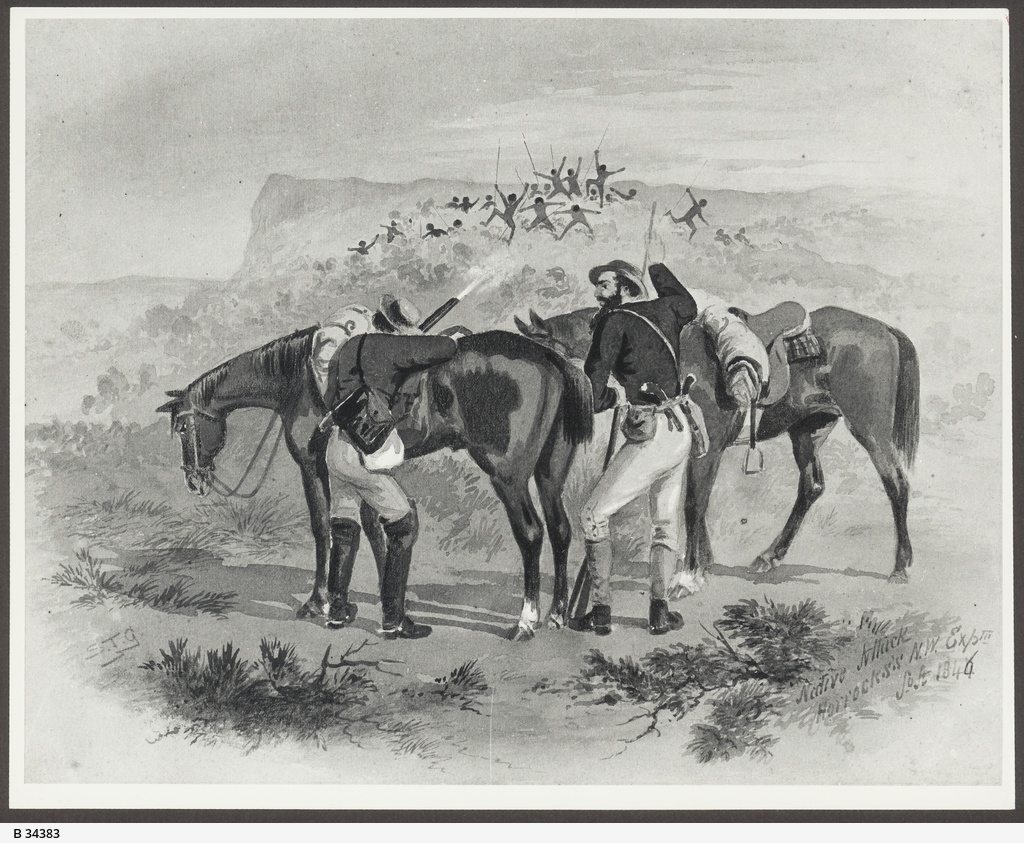
S.T. Gill and Horrocks Retrospectives
S.T. Gill accompanied John Ainsworth Horrocks' small expedition from July to September 1846. This article has a selection of retrospective works on the subject that are outside the scope of Gill's South Australian period catalogue.
The pictures in that series were identified as retrospectives of the 1846 expedition led by his late brother, John Horrocks. Several indicators led to this conclusion:
In March 1869 some watercolours by Gill and Louis Buvelot were advertised for auction in Adelaide.
On Tuesday, March 16, at 12 o'clock. TO CONNOISSEURS AND OTHERS. PARR & LUXMOORE will sell by auction, as above –
A few WATERCOLOURS, by Gill and Buvelot.
Subjects – South Australian Scenery.4
At the time both Gill and Buvelot were in Melbourne and it's unknown whether it was them or another seller who sent these works to Adelaide. (A following article clarified the works showed Australian scenery. I've seen no evidence of South Australian works by Buvelot.)
AUSTRALIAN SCENERY.–It will be seen by advertisement in another column that Messrs. Parr and Luxmoore will offer for sale, at their Mart, on Tuesday, a number of water-colour paintings, depicting Australian scenery. A few of the water-colours are by Buvelot, a Melbourne artist, whilst the remainder are by S. T. Gill, whose sketches of South Australian scenes many old colonists are familiar with. Mr. Gill, who, we understand, is at present in Melbourne, has travelled through South Australia, Victoria, and New South Wales, and reminiscences of his journeys are presented in the shape of a variety of very beautiful little views.
Mr. Gill, although an artist by profession, formerly farmed in conjunction with his father a piece of land at Coromandel Valley, and having in times gone by been chiefly connected with this colony he has produced a great number of sketches illustrative of South Australian scenery and bush life. One of the finest works in the group is a large water-colour representing a view of the Adelaide Plains, taken so far back as 1839. The whole of the views are neatly framed, and as delineating colonial scenes, &c., are as valuable as unique.5
The "large water-colour representing a view of the Adelaide Plains" may be one of the two Adelaide Plains works listed below.
Two Gill retrospectives that once belonged to Louis Buvelot were shown in a newspaper in 1930.6 At the time they were in the collection of Ernest McCaughan; they are now held by AGSA. Both were of the water mill on Tanunda Creek as it was in 1844 – the mill of Daniel Schlinke which was built in 1843.
Many of the works listed here are pencil sketches from two collections:
To see these works, with accompanying notes, just scroll down or jump to the List of Works.
As well as the retrospectives listed here, further ones listed by subject – see: S.T. Gill - Subjects.
You can scroll down to see all pictures along with detailed notes or click a link to jump to a specific work from the list.
Detailed notes each include a link to the map location for the view (where available).
 Death of the Boomer | State Library of Victoria H956
Death of the Boomer | State Library of Victoria H956
Artist: Gill, S.T. | Date: 1853 | Appleyard cat. 79 | 35.5(H) x 62(W) cm
Main listing: S.T. Gill - South Australia Retrospectives
Men with horses and kangaroo dogs have hunted a boomer (old male kangaroo). The trees appear to be Callitris glaucophylla (white cypress pine) which is commonly used by Gill in portraying the Horrocks expedition.
Signed and dated 1853 by Gill. Appleyard noted the reverse inscription: "Saml Thos Gill / 1850" and "The Death of the Kangaroo / ------ North of Mt. Horrocks / South Australia". (The 1850 reverse date may be misread or mistranscribed.) SLV notes front inscription (l.r.) "Death of the boomer / 1853". I have not been able to see this front or back at good resolution, however Appleyard reproduces this signature in his appendix and it's a good point of reference.
This seems likely to be one of the Horrocks related retrospectives favourably noted by The Argus in February 1853. Provenance: J.J. Blundell.
247
Dead Kangaroo | Mitchell Library, State Library of New South Wales PX*D 383 f.36
Artist: Gill, S.T. | Date: 1853~/1857~ | Appleyard cat. n/a
Main listing: S.T. Gill - South Australia Retrospectives
Two kangaroo dogs sit beside a dead kangaroo waiting for their master who is arriving on his horse. The trees appear to be Callitris glaucophylla (white cypress pine) which is commonly used by Gill in portraying the Horrocks expedition.
After Horrocks' fatal accident the expedition began to return south and for the sake of speed the party split up on 11 September 1846 with Horrocks and Kilroy going ahead. On the 11th and 12th Gill reported hunting kangaroo and emu with dogs, initially without success, until he and the cook both shot a kangaroo on the13th.
This seems likely to be one of the Horrocks related retrospectives favourably noted by The Argus in February 1853. The signature style is consistent with that.
437
Flinders Range, South of Mount Brown | Dixson Library, State Library of New South Wales DL Pd 130
Artist: Gill, S.T. | Date: 1853~/1857~ | Appleyard cat. n/a | 15(H) x 22.5(W) cm
Main listing: S.T. Gill - South Australia Retrospectives
This is a scene in the Flinders Ranges and is labelled (lower left): "F. Range, S of Mt Brown".
This is probably based on a Horrocks expedition picture - AGSA 8111HP88 - but Gill has added Aboriginal people and removed the plain in the background. At left two Aboriginal people are sitting while others walk up the ridge. Below there are other people with a fire, though not the Horrocks expedition with its equipment. (Similar to dated "Valley South of Mt Brown, Flinders Range" SLSA B 7812.) There are no Horrocks specific features in the picture which seems to present an idyllic scene of Aboriginal people and nature.
This seems likely to be one of the Horrocks related retrospectives favourably noted by The Argus in February 1853. The signature style is consistent with that.
436
Mt. Crawford Barrossa [sic] Range. So. A. | Mitchell Library, State Library of New South Wales PX*D 383 f.05
Artist: Gill, S.T. | Date: 1853~/1856~ | Appleyard cat. n/a
Main listing: S.T. Gill - South Australia Retrospectives
European man talking with Aboriginal man with two other Aborigines in a wurley near a watercourse; Mount Crawford in the background. It is a near identical landscape to "A Stockman after Cattle" (NLA NK286).
This retrospective may be one of the sepias of South Australian scenery favourably noted by The Argus in February 1853.
188
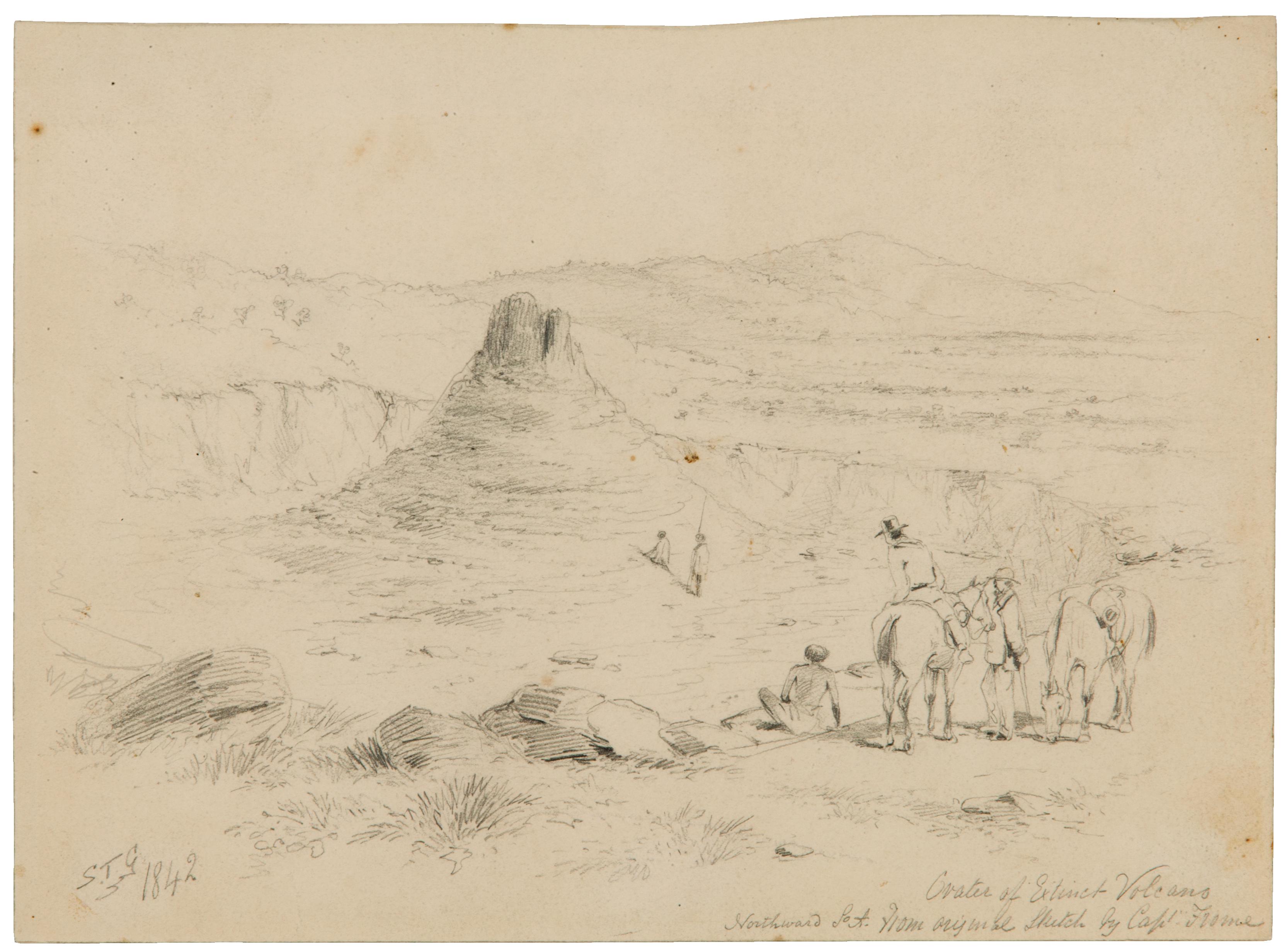 Crater of extinct volcano, Northward, South Australia | Art Gallery of South Australia 697HP8
Crater of extinct volcano, Northward, South Australia | Art Gallery of South Australia 697HP8
Artist: Gill, S.T. | Date: 1855~/1857~ | Appleyard cat. 27.3 | 19.6(H) x 26.8(W) cm
Main listing: S.T. Gill - South Australia Retrospectives
The view is of a rock formation seen on Captain E.C. Frome's 1843 northern expedition, which at the time was thought to be a volcanic crater. Gill's original image is likely based on Frome's watercolour. Gill did an early version of this scene for E.J. Eyre (SLNSW-M PX*D 73 f.5).
It is signed "STG 1842" by Gill, intended to indicate the date of the scene, not the artist's execution. However Gill has inaccurately recalled the date of the Frome expedition which was actually 1843. Appleyard (p58) says "the signature and date, which is incorrect, were added many years later in Melbourne". He dates the corresponding watercolour AGNSW 214.1975 to c.1870. The signature here has a curly tail on the G - a style Gill used around 1855/1857 - and this is a retrospective from that period.
261
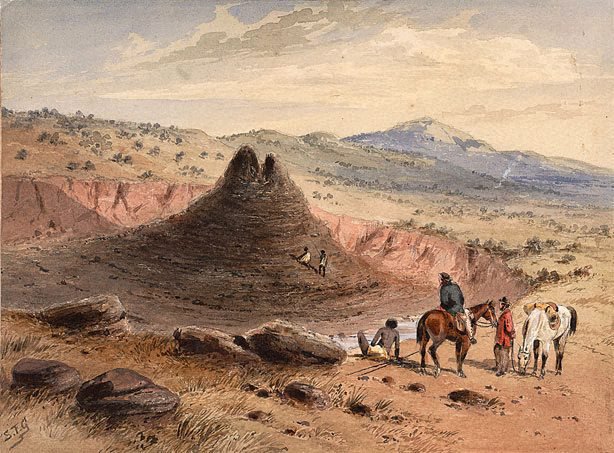 Landscape with crater and cone | Art Gallery of New South Wales 214.1975
Landscape with crater and cone | Art Gallery of New South Wales 214.1975
Artist: Gill, S.T. | Date: 1855~/1857~ | Appleyard cat. 27.4 | 24.1(H) x 32.5(W) cm
Main listing: S.T. Gill - South Australia Retrospectives
The view is of a rock formation seen on Captain E.C. Frome's 1843 northern expedition, which at the time was thought to be a volcanic crater. Gill's original image is likely based on Frome's watercolour. Gill did an early version of this scene for E.J. Eyre (SLNSW-M PX*D 73 f.5).
This painting is based on the pencil sketch AGSA 697HP8 and is likely to be a similar date. The January 1856 auction including a work of this subject is further evidence it is a retrospective from around 1855. (Appleyard (p58) dated this c.1870 based on signature and style.)
262
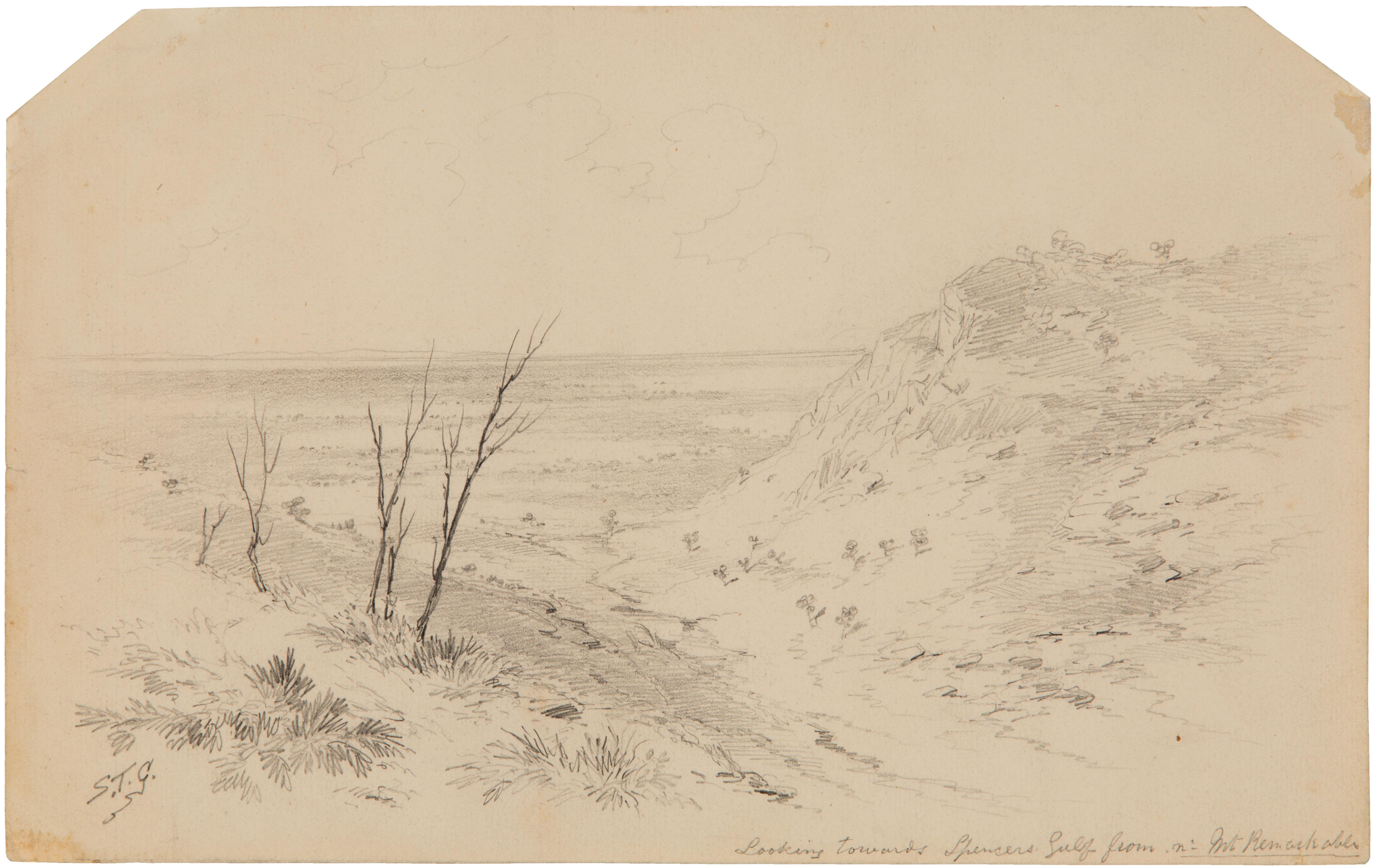 Looking towards Spencers Gulf from near Mount Remarkable | Art Gallery of South Australia 697HP6
Looking towards Spencers Gulf from near Mount Remarkable | Art Gallery of South Australia 697HP6
Artist: Gill, S.T. | Date: 1855~/1857~ | Appleyard cat. n/a | 17.9(H) x 27.7(W) cm
Main listing: S.T. Gill - South Australia Retrospectives
This Flinders Ranges scene is derived from Gill's Horrocks expedition pictures but there are no expedition specific features. This picture includes no Aboriginal people but is similar to Gill's idyllic scenes of Aboriginal people and nature. Similar to watercolour SLNSW V*/Sp Coll/Gill/3 f.1. The signature here has a curly tail on the G - a style Gill used around 1855/1857.
301
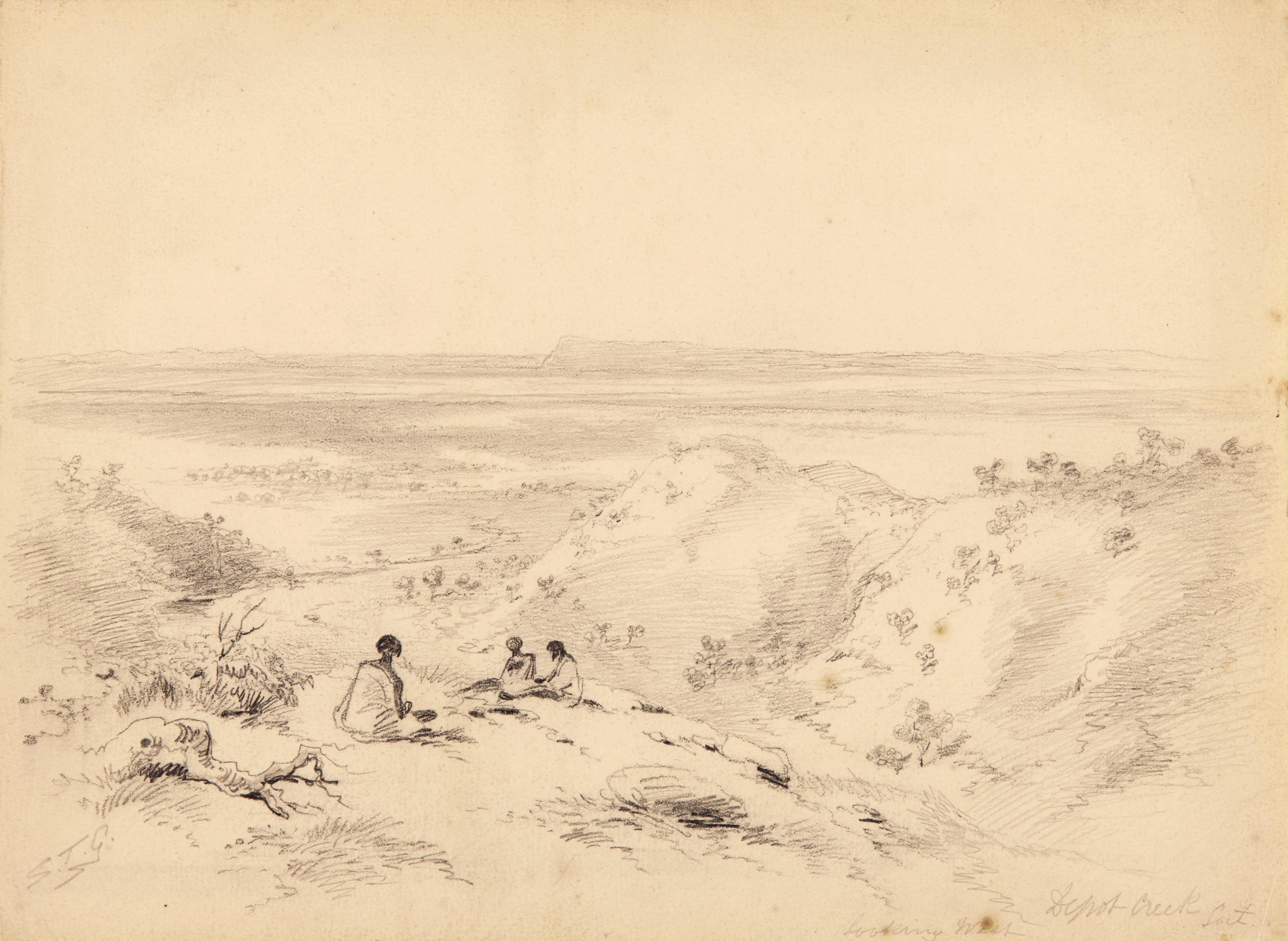 Depot Creek, South Australia, looking west | Art Gallery of South Australia 697HP7
Depot Creek, South Australia, looking west | Art Gallery of South Australia 697HP7
Artist: Gill, S.T. | Date: 1855~/1857~ | Appleyard cat. 94 | 20.6(H) x 29(W) cm
Main listing: S.T. Gill - South Australia Retrospectives
Depot Creek is below, the plain in the middle ground and Uro Bluff rises near the centre horizon. On 9 September 1846 at Depot Creek, the day before they left with fatally injured Horrocks, Gill "went to the top of the range sketching."
Appleyard (p91) thought this an original Horrocks expedition field sketch with a signature added many years later. However I think it more likely to be one of several South Australian retrospectives, along with others in this AGSA group.
Map | S. T. Gill and Horrocks expedition 1846
289
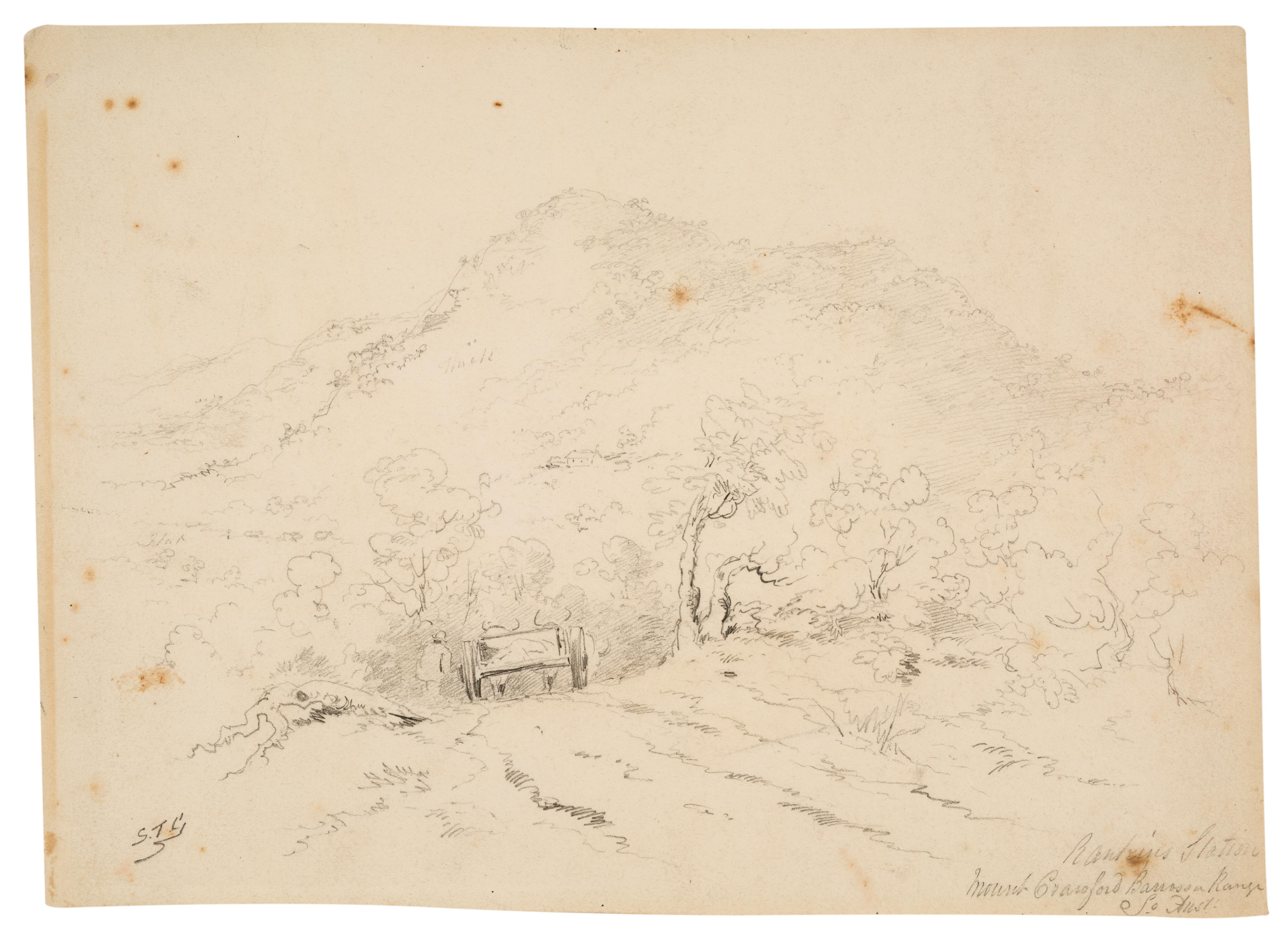 Rankine's Station, Mount Crawford, Barossa Range, South Australia | Art Gallery of South Australia 697HP9
Rankine's Station, Mount Crawford, Barossa Range, South Australia | Art Gallery of South Australia 697HP9
Artist: Gill, S.T. | Date: 1855~/1857~ | Appleyard cat. 19 | 19.5(H) x 27(W) cm
Main listing: S.T. Gill - South Australia Retrospectives
The view is just off a track before it bends and drops on approach to the hill, Mount Crawford, about 30 miles northeast of Adelaide. A man and bullock cart are on the road about to descend. It is not the couple shown in AGSA 744HP4.
Appleyard describes this is "a field sketch with artist's notes for later development as a watercolour" and thinks it is likely the preliminary sketch for the watercolour AGSA 744HP4. He dates this c. 1842-43 noting it was signed many years later in Melbourne.
The caption "So. Australia" by Gill suggests this picture may be a retrospective; the pencil of signature and sketch appears to be contemporaneous.
Gill's earliest identified road to Mount Crawford is NLA NK2042. Next is AGSA 744HP4 which is likely later 1840s and for E.C. Frome. This pencil sketch lacks the domesticity of, and is more generic than those. It is composed mostly like the Frome watercolour but differs in showing the bullocks and omitting the woman and left and right framing trees. Despite its similar appearance to the Frome picture this sketch seems to be a retrospective along with other pencil sketches in this AGSA group.
142
![Thumbnail image for Old Police Station, Murunda [Moorunde] So.A, 1843 | AGSA 697HP10](https://agsa-prod.s3.amazonaws.com/media/dd/images/103863-WR-697HP10.9b2bc24.jpg) Old police station, Moorundie, South Australia, 1843 | Art Gallery of South Australia 697HP10
Old police station, Moorundie, South Australia, 1843 | Art Gallery of South Australia 697HP10
Artist: Gill, S.T. | Date: 1855~/1857~ | Appleyard cat. n/a | 22.8(H) x 29.5(W) cm
Main listing: S.T. Gill - South Australia Retrospectives
A pencil drawing of Eyre's station at Moorunde. Like an earlier watercolour (AGSA 0.35) there is what appears to be a policeman, mounted, (and another?) walking towards the buildings.
The signature style, lack of mention of Eyre, the misremembered place name, the central building being larger and perhaps the style suggest this is a retrospective. It is likely derived from Gill's other work of this subject and/or the annotated sketch AGSA 709HP74 attributed to E.C. Frome. The timing of this work may perhaps have some connection to Eugene von Guerard who visited Moorunde in July 1855 (see sketches at SLNSW-DG DGB 16/vol. 3 f.23-26).
32
On the River Broughton Northward So. Australia. 18-- | Mitchell Library, State Library of New South Wales PX*D 383 f.02
Artist: Gill, S.T. | Date: 1855~/1857~ | Appleyard cat. 85 | 25.9(H) x 36.8(W) cm
Main listing: S.T. Gill - South Australia Retrospectives
Inscribed: "On the River Broughton Northward So. Australia". View from a rocky hillside with a river below. It is a natural scene with a single (Aboriginal?) person near the centre. Grass trees are featured.
The 1846 Horrocks expedition, with Gill, camped at the Broughton River on their way north. Horrocks' diary reads: "July 31.... Started at 11 a.m.; camped on the second crossing of the Broughton at 5 p.m." Gill painted the expedition's "Camp on the Broughton River" for the February 1847 exhibition no. 92 - a picture not known to be extant.
The pencil sketch and signature appear to be contemporaneous and, because the signature is of a much later style, this work seems to be a much later presentation but based on an original Horrocks expedition sketch.
185
Chambers Cattle Station - Mount Remarkable So. Australia | Mitchell Library, State Library of New South Wales PX*D 383 f.03
Artist: Gill, S.T. | Date: 1855~/1857~ | Appleyard cat. n/a
Main listing: S.T. Gill - South Australia Retrospectives
This pencil sketch is titled (lower right) "Chambers Cattle Station – Mount Remarkable So. Australia".
Chambers Station only appears to be referenced from about 1856 and is located much further north than Mount Remarkable, However the Mount Remarkable location suggests Gill's original scene could be from the Horrocks expedition, the party stopping at Malcolm & Campbell's cattle station at the foot of Mount Remarkable on 7 August 1846. So the title seems to be an anachronism.
Suggested alternative title: Malcolm & Campbell's Cattle Station, Mount Remarkable, South Australia
I think this is likely to be one of several South Australian retrospectives in this SLNSW-M group.
186
On the River Onkaparinga Above Horseshoe Township. 1848. | Mitchell Library, State Library of New South Wales PX*D 383 f.04
Artist: Gill, S.T. | Date: 1857~/1863~ | Appleyard cat. 29 | 13.4(H) x 27(W) cm
Main listing: S.T. Gill - South Australia Retrospectives
This is inscribed on the reverse: "On the River Onkaparinga / Above Horseshoe Township / So. Australia" (possibly by the artist) with "1848" (possibly added later). Appleyard dated this 1848 saying the date and signature were added later. (The signature style is later.) However I think this is likely to be one of several South Australian retrospectives in this SLNSW-M group.
187
Road to Montacute Mine - So. A. | Mitchell Library, State Library of New South Wales PX*D 383 f.06
Artist: Gill, S.T. | Date: 1857~/1863~ | Appleyard cat. n/a
Main listing: S.T. Gill - South Australia Retrospectives
This view is up Montacute Road towards Black Hill. The road skirts around the hill and runs to the Montacute Copper Mine in Section 5586. A watercolour of this scene is NLA NK1936. The signature is contemporaneous with the sketch and is of a style from 1857~ to early 1860s. I think this is likely to be one of several South Australian retrospectives in this SLNSW-M group.
Map | S. T. Gill - Adelaide District
189
On Leakes Station Mt Gambia [sic], 1850 | Mitchell Library, State Library of New South Wales PX*D 383 f.25b
Artist: Gill, S.T. | Date: 1857~/1863~ | Appleyard cat. 30.1
Main listing: S.T. Gill - South Australia Retrospectives
Possibly derived from NGV A1-1981 or NLA NK7073/6 but lacks the typical profile of Mount Gambier. The title is from a reverse caption, but may be unreliable - could it read 1856 instead of 1850? The signature is contemporaneous with the sketch and is of a style from 1857~ to early 1860s. I think this is likely to be one of several South Australian retrospectives in this SLNSW-M group. Appleyard says, with reservation, this picture "together with several others establishes Gill's presence in the area in the early 1850s", but my later dating negates this sketch as such evidence.
193
![Thumbnail image for Mt Gambia [Gambier], South Australia, from the South | QAGOMA 2:0622](https://collection.qagoma.qld.gov.au/system/files/object-images/2-0622_001_3.jpg) Mt Gambier, South Australia, from the South | Queensland Art Gallery & Gallery of Modern Art 2:0622
Mt Gambier, South Australia, from the South | Queensland Art Gallery & Gallery of Modern Art 2:0622
Artist: Gill, S.T. | Date: 1855~/1857~ | Appleyard cat. n/a | 20.1(H) x 26.9(W) cm
Main listing: S.T. Gill - South Australia Retrospectives
This seems to be a later reworking of NLA NK7073/6. The mountain is more prominent. Aboriginal people are absent from this version. The signature here includes a curly tail on the G - a style Gill used around 1855/1857. I think this is a South Australian retrospective.
786
Near Rivoli Bay - So. Australian Coast | Mitchell Library, State Library of New South Wales PX*D 383 f.07
Artist: Gill, S.T. | Date: 1855~/1857~ | Appleyard cat. n/a
Main listing: S.T. Gill - South Australia Retrospectives
A man with a walking stick and wearing a hat converses with two reclining Aboriginal people. At the base of a hill a dray pulled by six bullocks is driven towards the coast. A flag station is in the middle ground and beyond it a steamer.
Bowden (74) included this work, commenting that Gill "painted in the Mount Gambier area in 1850". However the evidence for Gill at Mount Gambier is lacking. See also S.T. Gill - Subject - Mount Gambier. On the other hand Rivoli Bay was also readily accessible by sea.
However I think this is likely to be one of several South Australian retrospectives in this SLNSW-M group. The signature here includes a curly tail on the G - a style Gill used around 1855/1857.
190
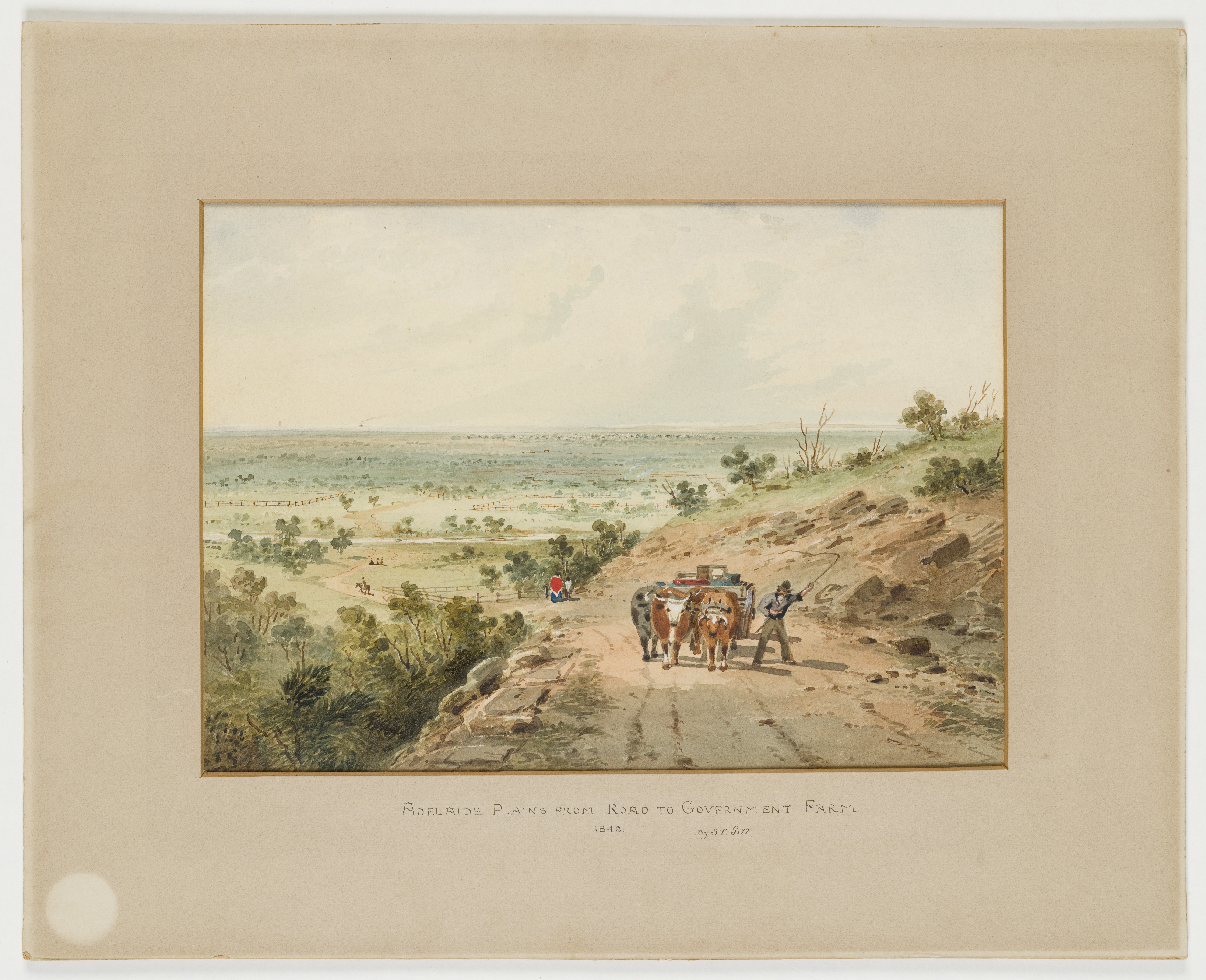 Adelaide Plains from road to Government Farm, 1842 | Dixson Galleries, State Library of New South Wales DG V*/Sp Coll/Gill/18
Adelaide Plains from road to Government Farm, 1842 | Dixson Galleries, State Library of New South Wales DG V*/Sp Coll/Gill/18
Artist: Gill, S.T. | Date: 1868~/1869~ | Appleyard cat. n/a | 26(H) x 36.3(W) cm
Main listing: S.T. Gill - South Australia Retrospectives
This is probably another version of "Adelaide Plains from Road to Government Farm, 1845" (AGSA 20037P30). In this case the title in the SLNSW catalogue may be a misreading of the year.
The Adelaide Plains as seen from the road to the Government Farm with the city in the distance (centre of picture). The view to the NNW from three or four miles from the southeast corner of Adelaide, likely on what is now known as Old Belair Road. The road was one very familiar to Gill as he travelled between the family's country section and town. The Government Farm was nearby - where Belair National Park is now. What looks like a steamer on the horizon (left) could be intended as South Australia's first steamer, the "Courier", which began operating in 1841.
A watercolour of this description - though would it be called large? - was auctioned in Adelaide in March 1869 after being sent from Melbourne. The style and signature is consistent with late 1860s to early 1870s and can be compared with "Road from Forest Creek to Bendigo in Victorian Goldfields 185-3" (1869) (SLV H86.7/21). So this is a retrospective of an 1840s scene painted around 1868-69.
Map | S. T. Gill - Adelaide District
124
 Adelaide Plains from Sleep's Hill | Art Gallery of South Australia 20037P30
Adelaide Plains from Sleep's Hill | Art Gallery of South Australia 20037P30
Artist: Gill, S.T. | Date: 1868~/1869~ | Appleyard cat. n/a | 24(H) x 33(W) cm
Main listing: S.T. Gill - South Australia Retrospectives
Captioned on reverse in pencil, likely by Gill: "Adelaide Plains from Road to Government Farm, 1845". AGSA title: "Adelaide Plains from Sleep's Hill".
Some detail from the picture is in Wilson and Borrow (151) - it was then in the Wilson Collection. This watercolour may be contemporaneous with "Adelaide Plains from road to Government Farm" (SLNSW-DG DG V*/Sp Coll/Gill/18). A watercolour of this description - though would it be called large? - was auctioned in Adelaide in March 1869 after being sent from Melbourne.
554
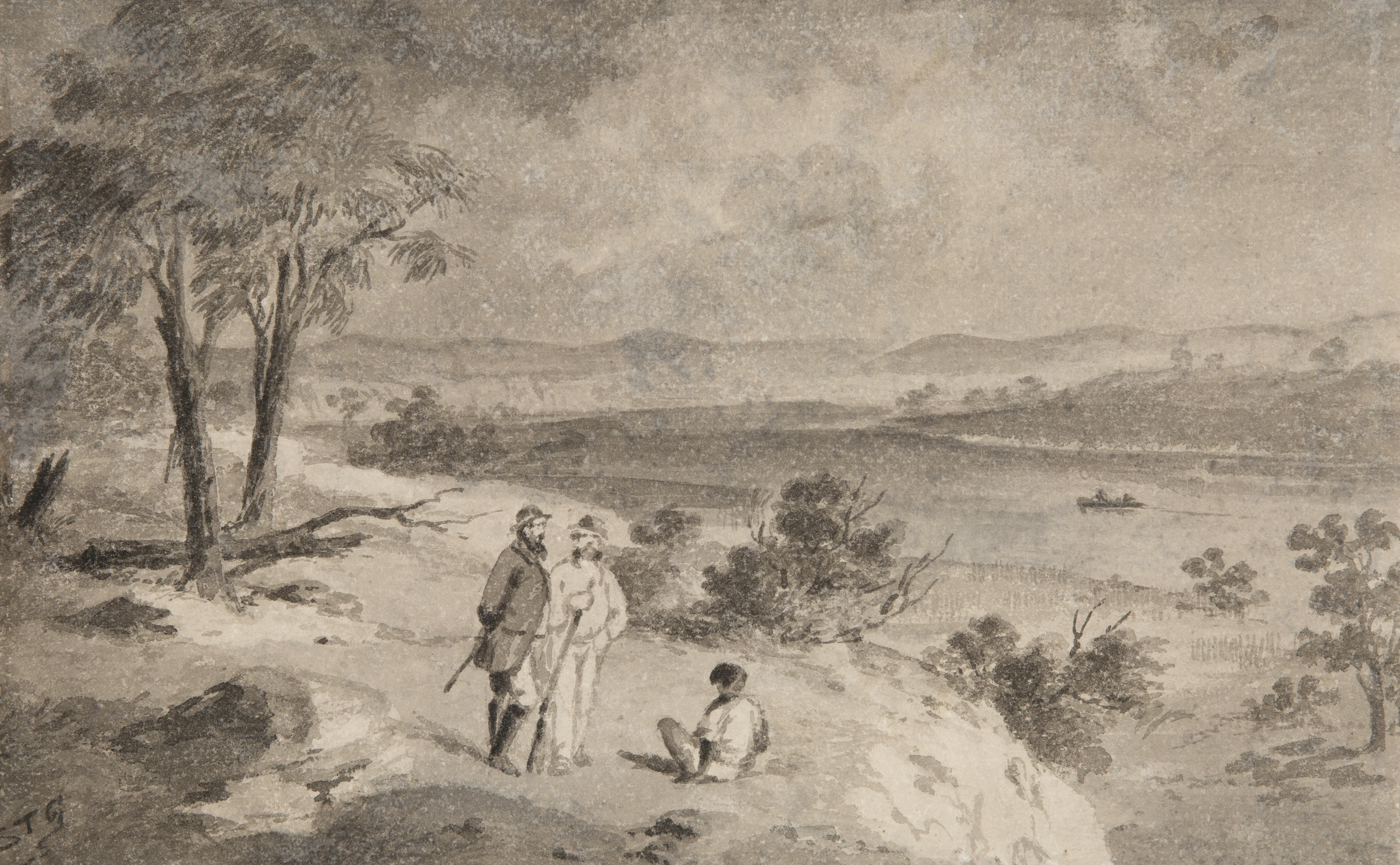 Metcalfe's Station, River Murray, 1844 | Art Gallery of South Australia 6310D4
Metcalfe's Station, River Murray, 1844 | Art Gallery of South Australia 6310D4
Artist: Gill, S.T. | Date: 1854~/1872~ | Appleyard cat. n/a | 22.5(H) x 35.8(W) cm
Main listing: S.T. Gill - South Australia Retrospectives
Appleyard didn't list this work, despite it being in the AGSA catalogue at the time. I've slightly retitled this to be identical with the reverse inscription which seems to be in Gill's hand. The "So. Australia" title implies a South Australian retrospective; and the style and signature are of a late date.
Occupation Licence applied for March 1846: Henry Metcalf, On the Murray <http://nla.gov.au/nla.news-article195933657>. Metcalf died in 1849. Metcalfe's extensive estate was put up for sale in December 1854 <http://nla.gov.au/nla.news-article207019949>.
The location is probably the lower Murray.
171
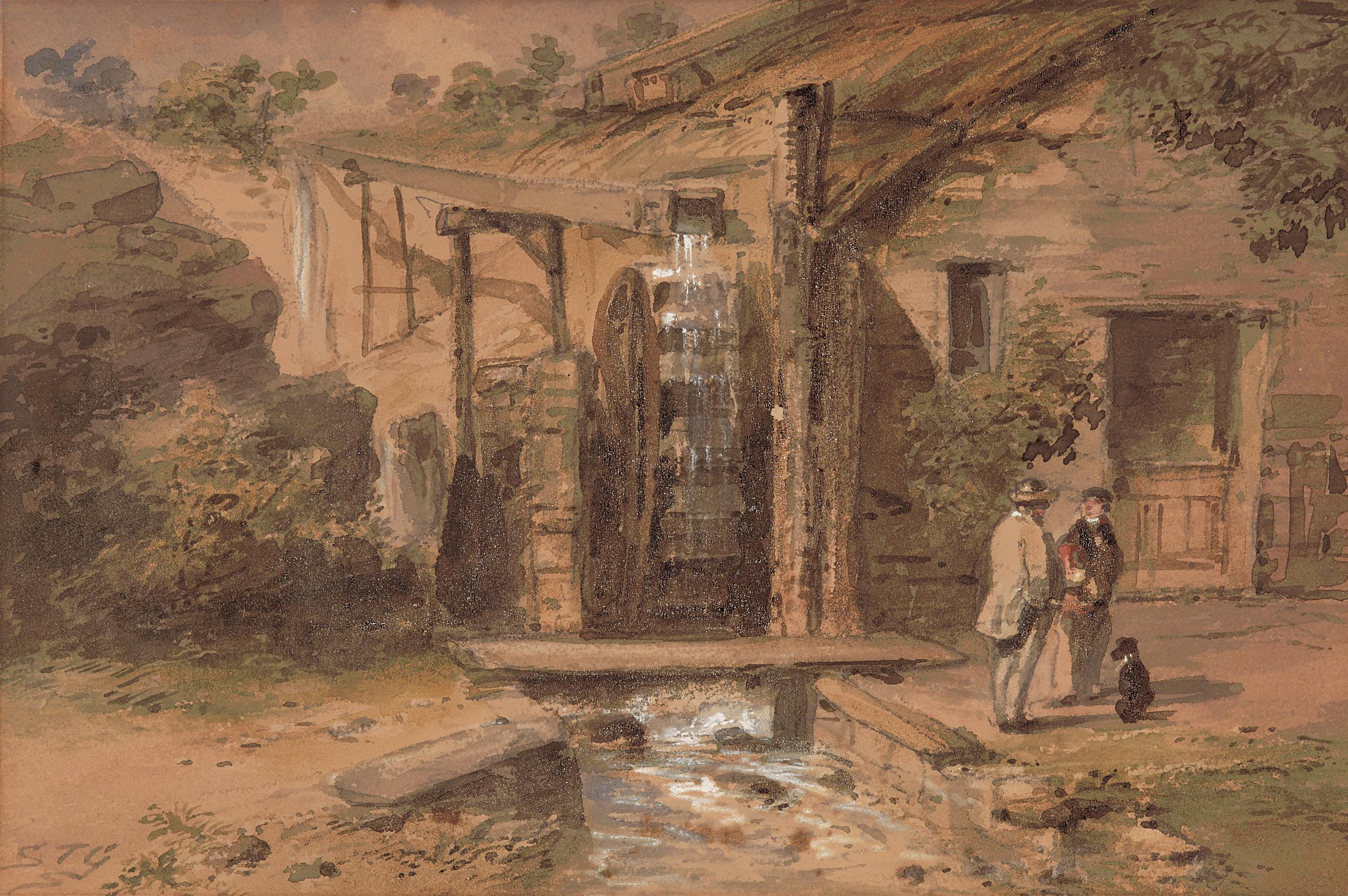 Old Watermill S.A. | Art Gallery of South Australia 688P9
Old Watermill S.A. | Art Gallery of South Australia 688P9
Artist: Gill, S.T. | Date: 1868~/1872~ | Appleyard cat. n/a | 17.3(H) x 26(W) cm
Main listing: S.T. Gill - South Australia Retrospectives
A water wheel attached to a single storey building - a flour mill - and fed by water from an elevated race coming from the top of a waterfall. This work is titled on the reverse "Water Mill, Tanunda Creek S.A." (and signed STG?). It was titled "Mill, Tanunda Creek (S.A.). 1844" in a 1930 newspaper where it was reported to have been once in the collection of Louis Buvelot.
This is the mill of Daniel Schlinke, built in 1843. "A water-mill has recently been erected for Mr Schlinke, baker, Grenfell-street. It is situated at the foot of the Barossa hills, on the Tannunda creek, just under a water-fall. The water, instead of being allowed to fall, is led by a trough to the water wheel, and thus derives an increase of power." Southern Australian, 18 August 1843: 2. http://nla.gov.au/nla.news-article71617716.
Daniel G Brock reported "Comparatively near to this village [Bethany], up one of the ravines, an enterprising German has erected a substantial stone mill, which is driven by water, conveyed in a trough three hundred feet to the water-wheel. The building reflects great credit on the builders, who have shown great skill in the erection. The mill is romantically situated up the gorge, and the water is seen breaking out in the different refts of the broken range." South Australian Register, 18 October 1843: 2. http://nla.gov.au/nla.news-article27445758.
Dated around 1869-72 from the signature style, this is a retrospective. It is on card. Based on the reported 1844 date, Gill would have originally sketched this scene in October 1844 when visiting the area for the Angas family - diary of John Howard Angas, 29 October 1844.
Map | S. T. Gill - South eastern South Australia
242
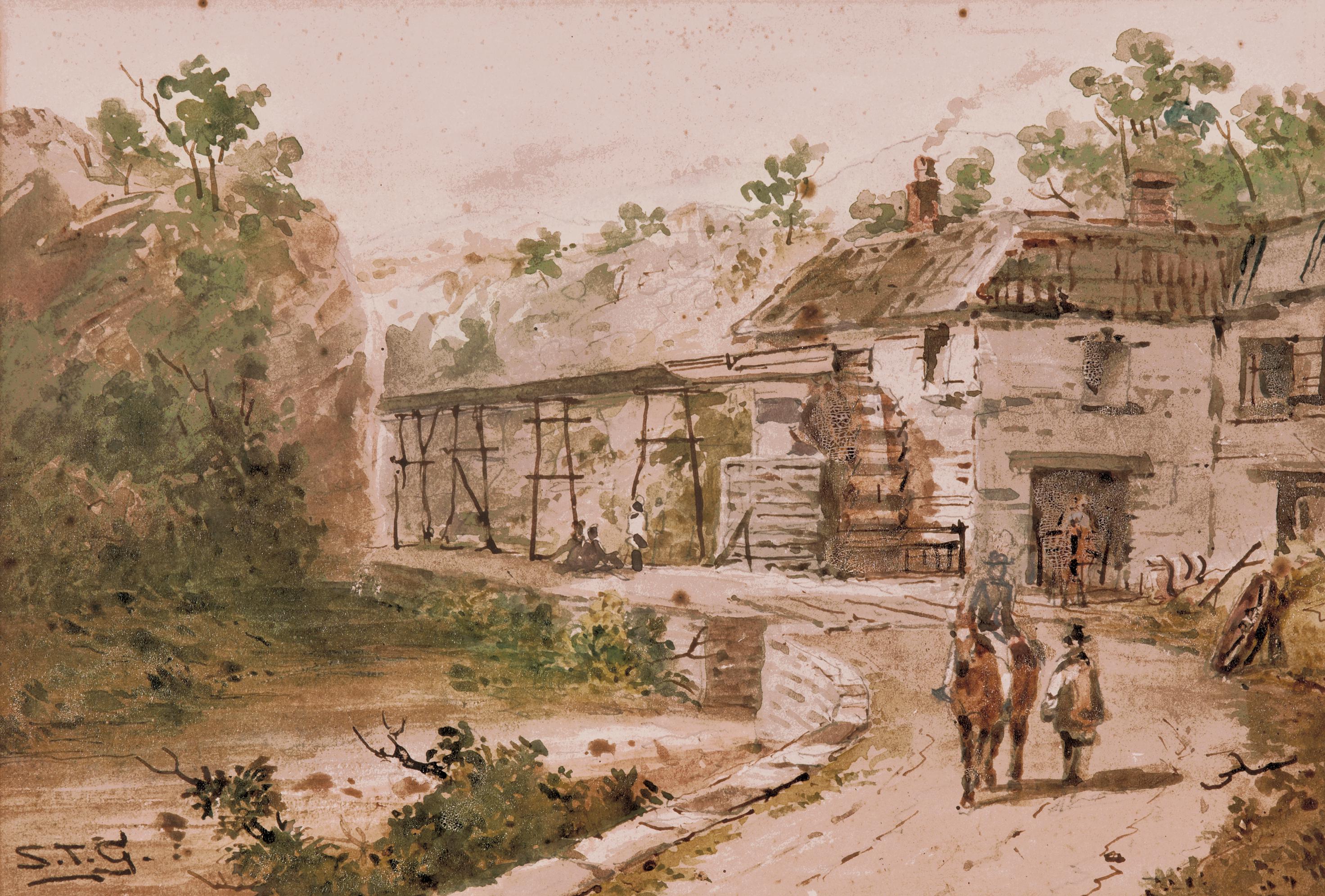 Old Water Mill | Art Gallery of South Australia 688P10
Old Water Mill | Art Gallery of South Australia 688P10
Artist: Gill, S.T. | Date: 1873~/1874~ | Appleyard cat. n/a | 19.9(H) x 29.3(W) cm
Main listing: S.T. Gill - South Australia Retrospectives
A water wheel attached to a two storey building - a flour mill - and fed by water from an elevated race coming from the middle of a waterfall. This is the mill of Daniel Schlinke, built in 1843. This work was titled "The Mill, Angaston (S.A.) in 1844" in a 1930 newspaper where it was reported to have been once in the collection of Louis Buvelot. Dated around 1873-74 from the signature style, this is a later reworking of another retrospective of this same scene - AGSA 688P9.
241
David Coombe. Original 31 May 2024. Updated 9 August 2025. Formatted 19 October 2025. | text copyright (except where indicated)
CITE THIS: David Coombe, 2024-2025, S.T. Gill - South Australia Retrospectives, accessed dd mmm yyyy, <https://coombe.id.au/S_T_Gill/S_T_Gill_South_Australia_Retrospectives.htm>